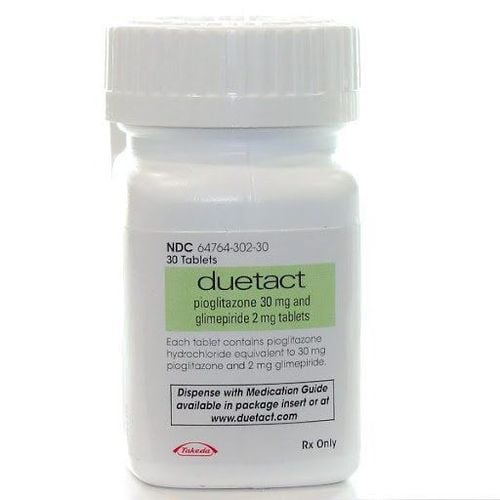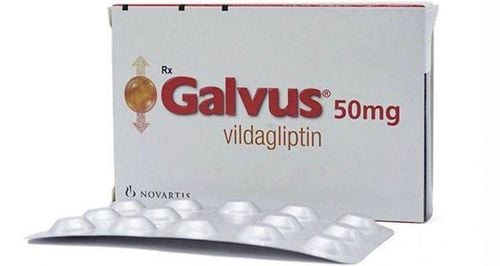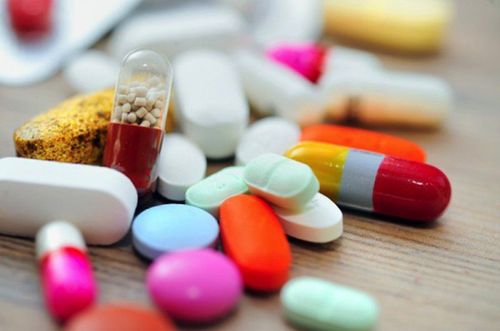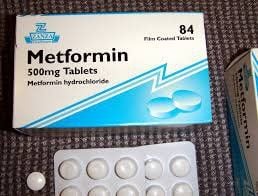This is an automatically translated article.
Diamicron mr containing the active ingredient gliclazide is indicated in the treatment of type 2 diabetes in adults, when non-pharmacological regimens such as exercise, diet and weight loss alone are not controlled. blood sugar. Let's learn about the uses and notes when using Diamicron mr drug through the article below.
1. Uses of the drug Diamicron MR tab
“What is Diamicron mr 60mg drug?” . Diamicron mr is a controlled release containing the active ingredient gliclazide in two strengths, 30mg and 60mg. The drug is indicated in the treatment of type 2 diabetes (non-insulin dependent diabetes mellitus) in adults, when non-pharmacological treatment regimens such as diet, exercise and weight loss alone. uncontrolled blood sugar.
2. Dosage of Diamicron MR tab
Dosage of Diamicron mr tab varies depending on the drug content, the patient's condition. The usual dose is 1 - 4 tablets per day (equivalent to a dose of 30 - 120mg / day) taken once at breakfast. The drug is in a controlled release form, so the patient should swallow the tablet whole, not broken or crushed. The recommended dose of diamicron 30 is as follows:
Initial dose: The recommended dose of Diamicron mr is 30mg/day. If blood glucose levels are effectively controlled, this dose can be maintained. Where blood glucose levels are not adequately controlled, the dose should be increased to 60mg, 90mg or 120mg/day. The interval between dose increases is at least 1 month (except in cases where the patient's blood glucose level does not decrease after 2 weeks of treatment). In that case, the dose may be increased at the end of the second week of treatment. The maximum recommended dose is 120mg/day.
In case of switching from treatment of Diamicron 80mg tablets to Diamicron mr controlled-release tablets: 1 diamicron 80mg tablet is equivalent to the effect of 1 dimicron MR pill. Therefore, switching can be carried out as long as the patient's blood glucose level is carefully controlled.
Switching from another class of oral antidiabetic to Diamicron mr :
Diamicron mr tab can be used in place of another oral antidiabetic. However, the dose and half-life of the therapeutic drug should be considered before switching to Diamicron mr ; Most do not need a transition period when switching therapy. The starting dose of Diamicron should be 30mg, adjust the dose in accordance with the patient's response; For previous treatment with a sulfonylurea with a long half-life, a drug-free period of 2 to 3 days may be required prior to administration of Diamicron mr (avoiding the additive effects of the two drugs). may lead to hypoglycemia). Combination of Diamicron mr with other antidiabetic drugs:
Diamicron mr 60mg, 30mg can be used in combination with alpha glucosidase inhibitor drugs, biguanide or insulin; In patients not adequately controlled with Diamicron mr, combination therapy with insulin may be instituted under close medical supervision. Dosage of Diamicron mr in special subjects:
Elderly: No need to adjust the dose in patients under 65 years old; Patients with renal impairment: For patients with mild to moderate renal impairment, the same dose can be used as in patients with normal renal function, accompanied by a close monitoring regimen; Patients at risk of hypoglycemia: For patients with malnutrition, poor nutrition, severe or poorly compensated hormonal disorders (hypothyroidism, hypopituitarism, decreased ACTH), use prolonged corticosteroid therapy. long term, severe vascular disease... the recommended minimum dose is 30mg/day; Children: There are no data on the efficacy and safety of Diamicron mr in children and adolescents.
3. Treatment of drug overdose
Overdose of Diamicron mr tab in particular and sulfonylurea drugs in general can cause hypoglycemia. Mild symptoms of hypoglycemia, without neurological signs or loss of consciousness, should be corrected by carbohydrate intake, dietary modification and/or modification.
The patient should be closely monitored until the doctor is sure that the patient is out of danger. Serious hypoglycemic reactions including convulsions, coma, or other neurological disturbances may occur and the patient should seek medical attention as soon as possible.
Where a hypoglycemic coma is detected or suspected, the patient should be given a rapid intravenous injection of 50ml of high-concentration glucose (20% to 30%). This is followed by a continuous infusion of a lower concentration (10%) glucose solution at a glycemic rate above 1 g/l.
4. Diamicron MR tab drug side effects
Diamicron drug can cause some side effects as follows:
Hypoglycaemia: Hypoglycemia occurs when the patient does not have a regular diet, especially skipping meals. Symptoms of hypoglycemia include intense hunger, headache, vomiting, nausea, fatigue, anxiety, sleep disturbances, aggression, poor concentration, slow reactions, decreased awareness, confusion, and weakness. , loss of language , dizziness , feeling helpless ... Usually the symptoms will go away when the patient is loaded with sugar (carbohydrates). In case of severe or prolonged hypoglycaemia, the patient needs to be treated in an emergency or hospitalized for timely treatment; Gastrointestinal disorders: Symptoms may include nausea, abdominal pain, indigestion, diarrhea, and constipation. These symptoms can be prevented by taking medicine at breakfast; Skin and subcutaneous tissue disorders: Symptoms include urticaria, skin rash, pruritus, angioedema, blistering; Blood and Lymphatic System Disorders: Rarely hematologic changes include leukopenia, anemia, agranulocytosis, and thrombocytopenia. These symptoms are reversible upon discontinuation of drug therapy; Hepatobiliary disorders: Increased levels of liver enzymes such as ALT, AST; hepatitis... Discontinue drug therapy if symptoms of cholestatic jaundice appear; Eye Disorders: Ocular disturbances may be transient, especially during initiation of therapy (due to changes in blood glucose levels).
5. Notes when using the drug Diamicron MR tab
5.1. Contraindications Contraindicated to use diabetes drug Diamicron mr in the following cases:
Patients are allergic to gliclazide to any component of the drug diamicron, allergic to other drugs of the sulfonylurea, sulfonamide group; Patients with insulin-dependent diabetes mellitus (type 1 diabetes mellitus); Patients with diabetic coma , pre-coma or diabetic ketoacidosis ; Patients with severe liver or kidney failure; The patient is being treated with miconazole; Women are breastfeeding. 5.2. Precautions for use Patients need to use the drug exactly as prescribed by the doctor to achieve an appropriate blood sugar level. Thus, in addition to regular medication, patients need to follow the exercise, diet and weight loss regimen if necessary.
During gliclazide treatment, patients should monitor their blood glucose levels and glycated hemoglobin (HbA1C) levels on a regular basis. During the initial period of treatment with diamicrons, the risk of hypoglycemia may be increased, so patients should be closely monitored during this time.
A decrease in blood sugar may occur in the following cases: Patients who are on a diet, malnourished, people who often change their diet...
The blood sugar lowering effect of the drug diamicron 30, diamicron 60 says particular and any antidiabetic drug in general may degrade over time in some patients. This is explained by the progression of disease severity or the patient's ability to decrease response to treatment. This is also known as secondary failure of treatment.
Ability to drive - operate machines: Diamicron tab mr does not affect the ability to drive or operate machines. However, patients should be informed of the symptoms of hypoglycemia and be careful when driving or operating machinery.
Pregnant women: Diabetes treatment should be started before pregnancy to help reduce the symptoms of birth defects related to uncontrolled blood sugar. Oral hypoglycemic agents are not suitable for treatment in pregnant women, insulin is the first choice. It is recommended that oral antidiabetic therapy be switched to insulin before pregnancy (or as soon as pregnancy is discovered).
Lactation: There are no studies demonstrating the excretion in breast milk of gliclazide and its metabolites. Therefore, in order to avoid the risk of hypoglycaemia in the neonate, the use of the drug is contraindicated in lactating women.
6. Drug interactions
6.1. Combination of drugs that cause hypoglycaemia Combination of drugs is contraindicated: Miconazole (systemic use, oral mucosal gel) with Diamicron mr, because it increases the hypoglycemic effect, even coma.
Combination drugs should not be used:
Phenylbutazone: Increase the hypoglycemic effect of sulfonylurea drugs; Alcohol: Hyperglycaemic response may lead to hypoglycemic coma. Therefore, avoid drinking alcohol and other alcoholic beverages during treatment with Diamicron. Combination with caution: Other antidiabetic drugs such as acarbose, insulin, thiazolidinedione, metformin; beta-channel blockers, ACE inhibitors, MAOIs, non-steroidal anti-inflammatory drugs.
6.2. Combination of drugs that cause hyperglycemia Contraindicated drug combination: Danazol Combination drugs that should not be used: Chlorpromazine, glucocorticoids (for systemic and local use), tetracosactrin, salbutamol, ritodrine, terbutaline (intravenous use). Combination with caution: Anticoagulant warfarin. Diamicron mr containing the active ingredient gliclazide is indicated in the treatment of type 2 diabetes in adults, when non-pharmacological regimens such as exercise, nutrition and weight loss alone fail to control glucose levels. blood. To ensure the effectiveness of treatment and avoid side effects, patients need to take the medicine exactly as directed by the doctor, professional pharmacist.
Follow Vinmec International General Hospital website to get more health, nutrition and beauty information to protect the health of yourself and your loved ones in your family.
Please dial HOTLINE for more information or register for an appointment HERE. Download MyVinmec app to make appointments faster and to manage your bookings easily.













